For the last few weeks, we’ve heard rumblings of some discouraging news on the injury front, and this morning, Joe Girardi confirmed the dire diagnoses: Neither Alfredo Aceves (back) nor Damaso Marte (shoulder) will return to the Yankees’ bullpen this year. Marte, out since July and still under contract for next year, could need surgery, and Aceves, who threw just 12 innings before a disc problem shelved him in May, is still under team control. For the sake of depth and with memories of 2009 dancing through our heads, it’s a shame that these two pitchers aren’t coming back, but with Boone Logan’s emergence and the solid, if not spectacular, work out of the pen lately, the team has the arms to cover these two injuries.
Marte may be headed for shoulder surgery
The Yankees have been without the services of Damaso Marte since before the All Star break because of a sore throwing shoulder, and now it sounds like the lefthander might be headed for the surgeon’s table. He felt some discomfort when he tried to throw in Chicago last weekend, but it’s unclear what the extent of the surgery would be. Perhaps it’ll just be a routine clean up instead of a full blown reconstruction. Either way, it doesn’t sound like the Yanks will get their second lefty back for the playoffs, which is a shame because he really crushed lefthanded batters this year (.146/.200/.268 against).
Shoulder surgery is never a good thing, but we’ll always have the 2009 playoffs, Damaso.
First Half Review: 7 who fell short
On Monday night Ben reviewed seven Yankees who performed better than we could have expected heading into the season. Those players have helped keep the team moving as various players slumped. Some of those slumps lasted longer than others, and that resulted in a number of players falling short of the expectations we had for them early in the season.
Nick Johnson

Was an injury to Nick Johnson expected? To some extent it had to be. Even last year, when he was mostly healthy while playing for the Nationals and Marlins, Johnson still hit the disabled list for two weeks. But a season-ending injury in May? While it was a certain possibility I’m not sure any but the most cynical of fans had that in mind. It pays to be a cynical fan in that way — if you’re right you get to gloat and call everyone else an idiot, if you’re wrong you’re pleasantly surprised. It works well in a sport where the failures far outweigh the successes.
Even while Johnson was in the lineup he didn’t perform to expectations. As normal his OBP was high, on the strength of his superhuman 24.5 percent walk rate, but Johnson didn’t exactly hit to expectations. In fact, he had just 12 base hits in his 98 PA, while he walked twice as many times. Half of his hits did go for extra bases, a huge plus in a larger sample but mostly useless in Johnson’s case. He has been the big disappointment this season.
Chances are his season is done, even though the Yankees could use someone exactly like him right now. That’s a shame. There was so much potential there, and the Yanks realized none of it. They had to choose among injury risks for their DH spot, and they picked the one guy who didn’t stay healthy. Such is life.
Mark Teixeira
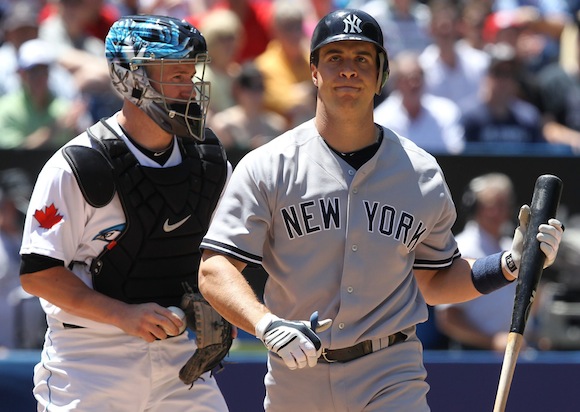
It hurts me just a little to put Teixeira on this list. Sure, he was the source of mass frustration in April, and then again in May, and then for a little of June. His slumps have put him in a tough spot, a .254/.360/.465 line headed into the break. In terms of his career that’s off the mark, but a .361 wOBA looks pretty nice all considered.
Teixeira produced the worst April of his career, a mere .136/.300/.259, .271 wOBA. We were used to Tex getting off to slow starts, but this was much worse than last year when he hit .200/.367/.371, .330 wOBA. May started off well but then he slumped again and finished the month with a .280/.366/.475 triple slash, .366 wOBA. In June he stumbled again, a .353 wOBA, but he has recovered in July with a .545 wOBA through 50 PA. That makes his May 1 through the break numbers look a bit better: .291/.380/.529. I don’t think anyone will complain if he maintains that pace for the rest of the season.
Derek Jeter
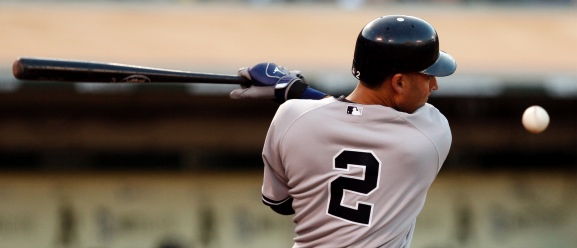
At the beginning Derek Jeter was an equal opportunity first-pitch swinger. It seemed like he was swinging at all of them and, for the most part, grounding them all to shortstop. Yet through his first 23 games he was hitting .333/.367/.510. The lack of walks was a bit concerning, but as long as Jeter was hitting all was well. Unfortunately, his torrid start ceased right there.
In the course of just a few weeks Jeter saw his average tumble to .266, a span during which he was 12 for 71. He then climbed back over the .300 mark for a bit, but has steadily declined since. He peaked on June 1, when he was hitting .307 after a 2 for 3 day. Since then he’s hitting .221/.319/.321.
Why are we citing Jeter’s batting average above all else? Because his game seems so dependent on it this year. Or, at least, it was. Since the April in which he walked in just 3 percent of his plate appearances, Jeter has steadily improved, walking 6.4 percent of the time in May before walking in nearly 13 percent of his PA in June and July. His BABIP has fallen off in these months, so if he can just put it all together I think he can have a fine second half. It won’t look like last year, but it should look a bit better than 2008 if all goes well.
Alex Rodriguez
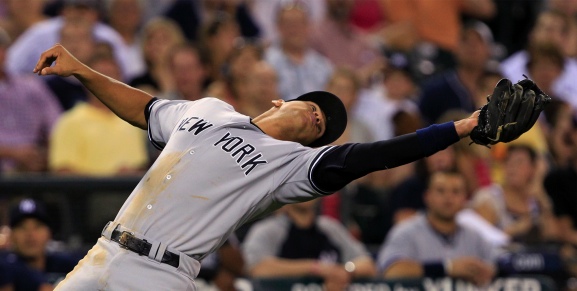
Again, this is not a guy I wanted to put on the list, but with his subpar first half numbers I couldn’t leave him off. A-Rod has had some shining moments for sure, including three grand slams and a few game-changing hits. Still, on the whole he’s been something of a disappointment, probably in part because of his hip issues.
Everything is down for Alex this year, even his strikeout rate. His defense has been fine, but suffered a bit when his hip hurt him the most (just before he sat out against Philly and Houston). Since June 1 he is hitting .232/.298/.464, which is nice from an isolated power perspective, but even then it’s sub-par for A-Rod. Hopefully his proclamation at the Home Run Derby, that he felt stronger, holds true in the second half. The Yanks will need his production.
Curtis Granderson
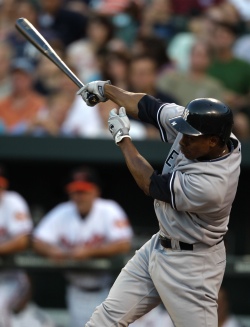
One thing we knew when the Yankees acquired Curtis Granderson is that he’d need to work with Kevin Long in order to correct the problems that plagued him last year. They went beyond mere bad luck on balls in play; Granderson was putting the ball in the air more often, and had been especially pull-happy. While lefties pulling the ball at the Stadium can produce quality results, it doesn’t usually make for a well-rounded player.
Granderson’s first half results can be rated as nothing but a disappointment. He has produced even less than he did last year, a .319 wOBA. His walk rate and power are down, which doesn’t go well with his .280 BABIP. The good news is that he’s putting the ball on the ground and hitting it on a line more often, so maybe he’s working out of it.
Unlike the others on the list I don’t have as high expectations for Granderson in the second half. It took Long a year to transform Swisher, just like it took him time to get Robinson Cano into a good spot. I imagine that we might see some improvement from Granderson in the second half — he can’t really do much worse at this point — but I don’t expect it to be revelatory. I will still maintain faith, however, that we’ll see a different Granderson in 2011.
A.J. Burnett

In April and May Burnett killed opponents, a 3.28 ERA and 3.37 FIP. He had a few bad games in there, notably a nine-run performance against Boston, but for the most part he was pitching very well despite a curveball that wasn’t working like normal. So his strikeouts were down, but he made up for that by keeping the ball on the ground more often than last year. But then June came and ruined everything.
Burnett’s June totals: 23 IP, 35 H, 29 R, 29 ER, 17 BB, 19 K, 9 HR. He had allowed four home runs in his previous 77.1 IP. That’s the entire reason he comes in below expectations. Even with his two excellent starts in July he still has a 4.75 ERA and 4.73 FIP. That’s not what the Yankees are paying $17.5 million for. Burnett will have to hold up his end of the deal in the second half. Thankfully, everyone surrounding him is picking up the slack.
The non-Mo bullpen
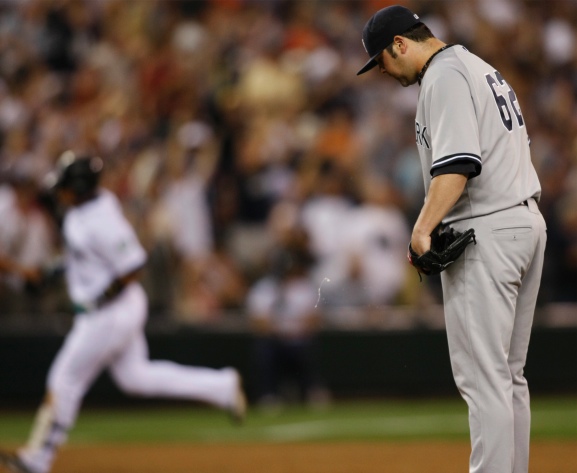
The list could go on forever if we listed all of these guys individually, so it’s best to just lump them together. In terms of peripherals the unit has been adequate. They rank 4th in the AL in OBP against, 5th in SLG against, and 4th in WHIP. The strikeouts could be better, 7.43 per nine, 7th in the AL. But as a unit they’re simply giving up too many runs, a 4.14 ERA that’s good for 9th in the league.
Here’s a quick rundown of the individuals in the pen and their deficiencies:
Joba: Too many hits allowed. Not sure if this is luck or him just trying to not walk guys. He has walked only 14 in 37.1 IP, a decent rate, but one he’s going to have to eventually bring down if he’s going to be a success in the setup role.
Robertson: Still trying to work off that Abreu grand slam. He walks way, way too many guys, though his strikeout numbers are again impressive, 32 in 29.2 IP.
Park: Hits, homers, and a lack of velocity. He’s dialed it up recently, but with few positive results to show for it. His time is running short.
Marte: Again, too many walks. Lefties are hitting just .146 against him and he has allowed just one extra base hit to the 31 righties he’s faced, but those walks — eight to righties — will hurt plenty. Especially with no one else in the pen to pick up for him.
Gaudin: Again with the walks. I see little reason to keep him around. He won’t once the next guy returns.
Mitre: Very good all considered. His WHIP is 1.00, fueled by a low hit rate, but maybe that’s something he can capitalize on in the pen. Once he returns from his batting practice injury I think he’ll get a shot in one-inning stints.
A bullpen band-aid: More Robertson, Marte
Last night we undoubtedly witnessed one of the most exciting, satisfying wins of the 2010 season. The Yankees brought back some of that 2009 comeback luster, taking advantage of a seemingly fatigued Jonathan Broxton. The job might have been a degree easier, though, had Joba Chamberlain not surrendered a run in the bottom of the eighth, extending the Dodgers’ lead to four. At that point the game seemed all but over.
Joba’s performance again highlighted one concerning aspect of the 2010 Yankees, their bullpen. The starters have, for the most part, done a great job of limiting the need for relief pitchers. They’re going deep into games and are handing the ball to Joba or even Mo. But with Joba’s inconsistencies, perhaps he’s not the man to take the ball in every eighth inning situation. But that only creates another question. Who would provide the bridge to Mariano?

While the Yankees just finished one of their best games of the season, they’re still less than a month removed from their worst loss. On May 29 they blew multiple big leads to the Indians, eventually dropping the game 13-11. Once again Joba was front and center. He took the ball with two outs in the seventh and not only allowed both inherited runners to score, but allowed four of his own. All with just one out left to record. The Yankees bullpen to that point didn’t help much. David Robertson hit a guy and allowed him to score after a steal. Sergio Mitre walked a guy, and while Damaso Marte retired the only batter he faced, Joe Girardi still decided to go to Joba rather than let Marte finish the job. In other words, while Joba ultimately blew it, the inning was a team effort in futility.

Since that game Robertson has been much better. He has appeared in nine games and has pitched nine innings, allowing just one run on eight hits and four walks, while stranding the only runner he has inherited. He’s still not perfect, of course. Those four walks stick out, as do the 164 pitches it has taken him to finish those nine innings. But he also has plenty going for him. Even with his poor start he has struck out more than a batter per inning. His walk rate is in line with last year, and as we saw then he improved on that dramatically in the second half, walking just seven in 21.0 second-half innings. He has also kept the ball in the park, allowing just three home runs all season. Two of them came in one particularly poor performance against Baltimore; the other was that infamous grand slam against Anaheim at the home opener.
From Marte we see similar flaws and strengths. He keeps the ball in the park, allowing just one home run to the 65 batters he’s faced. He’s not as proficient as Robertson with the strikeout, just 10 in 14.2 innings this year, but he still has a quality rate. His walk rate is also troubling, as he’s walked one more than he’s struck out. That, however, might be attributable to his odd usage patterns. In fact, he’s walked only two batters in appearances that have come within two days of his previous one. In other words, it seems like the old adage holds true for Marte: he needs to actually pitch in order to stay sharp. To that end, four of his walks came in his two appearances prior to last night. He had gone three and then five days between appearances. That’s not to say that he’ll miraculously stop walking guys when given consistent work, but it doesn’t look like that could hurt.
The issue standing between Marte and Robertson, and more prominent roles, is that of trust. While Joe Girardi doesn’t share the same trust issues as his predecessor, he does favor certain relievers in certain situations. When his team has a small lead in the late innings, he puts his trust in Joba Chamberlain. At this point, that trust appears misguided. Joba’s peripherals look good, and in the long run I feel his results will move more in line with his strikeouts, walks, and home runs allowed. But for now the Yankees need another option, or options. There aren’t many viable candidates sitting out in the bullpen. Marte and Robertson, it appears, present the best cases to receive more high leverage innings.
Turning to Marte and Robertson is not the ideal solution, but neither is continuing along the current path. Joba just isn’t getting the job done. While I think he eventually will, the Yankees need a solution that will work during the next couple of weeks. With the way they’ve been pitching lately, Marte and Robertson present the best options. Neither has pitched much so far. Marte is on pace for 31.2 innings this season and Robertson is on pace for 54. Both can handle more, and if the Yankees want to explore all possible options to fix the bullpen problem they’ll get that chance. After all, why would they go and trade for a reliever if they don’t explore all possible internal options?
A closer look at Marte
Note: This was written prior to Marte’s appearance against Thome this afternoon. Sure, he was able to get Thome out, but he still made a few mistakes that ended up not hurting him. That’s baseball! I’m hesitant to say “Marte is back” as a result, though he did look improved.

With all the issues the Yankees are currently facing, the bullpen is relatively low on the list of major concerns for the team. Joba has looked great of late, Mariano is Mariano, Park and Aceves should be returning shortly, and our AAA callups Ivan Nova and Romulo Sanchez impressed in their short stints. With major and minor injuries throughout the roster, the struggles of Damaso Marte, David Robertson and Boone Logan aren’t going to be front page news in Yankeeland. After all, two of the three are just lefty specialists (one likely to be sent down when Park returns) and Robertson could be sent to AAA to work on his issues. Whatevs. But make no mistake, all is not well on the left-turn front.
Let’s take a look at last night’s game. Marte entered with a man on second and Joe Mauer at the plate. Marte misses on a first pitch slider outside. He returns with a fastball for a called first strike. It had good velocity but ended up nowhere near where Cervelli set up. At this point, I’m fairly worried. If there’s a short list of guys you absolutely do not want to miss on pitches, Mauer is on it. Then, for some reason, Damaso leaves a slider without much movement in the center of the plate, about belt high. Against Joe Mauer he’s fairly fortunate the ball was only smoked for a single, scoring Denard Span from second. Unfortunately, Brett Gardner attempted to nail Span at the plate and his throw was way up the line. Why he did that is a mystery to me.
Herein lies the problem: Marte was brought in as an expensive reliever (the contract extension still seems a bit of a blunder as of this writing) with the one goal – to get out tough lefties. He hasn’t done it with much regularity a a Yankee and while Burnett had command issues (and certainly not helped by a pygmy-sized strike zone), wouldn’t you rather have the better pitcher face the better hitters? Mauer’s no slouch against lefties, either. He hits them to the tune of .313/.376/.417. I understand why Joe made the decision and it’s much easier to second guess the Yankee manager from the comfort of my garden apartment, but I’d argue you’d rather have the better pitcher in against the better pitcher, especially if neither has much of a platoon split. All of Burnett’s pitches are better than Marte’s offerings.
Back to the action. So Mauer moves up to second and Morneau is now the batter. Morneau hasn’t been phenomenal against left-handers throughout his career, but as Mike noted in last night’s recap, why let their only really dangerous hitters beat you? With first base open, you’d think they’d not give Morneau anything to hit, if not walk him altogether, right? On the sixth pitch of the at bat, Morneau slams another high slider with little break. Boom! Double! Mauer scores. With the lead gone, Girardi then intentionally walks Michael Cuddyer (a righty) to get to Jason Kubel (a lefty, who has managed to do virtually nothing but walk and strike out all year). He flies out to Marcus Thames, inning over. But the damage was done. If not for A-Rod’s heroics, Marte likely becomes the game’s goat, though true to form, Randy Winn would have given him a good run at it.
Damaso has some alarming peripherals this year. Now bear in mind, he hasn’t had many innings to accumulate a definitive sample size, but the numbers etch out many of his struggles. Let’s first take a look at plate discipline:
On the year, Marte is eliciting an O-Swing % of 16.2%, which basically says that his stuff doesn’t have a lot of movement where hitters bite at balls slicing out of the zone. In fact, batters are only swinging at a total of 31.6% of Marte’s pitches, about 15 points lower than league average. It gets worse. Only 40.4% of Marte’s pitches find themselves in the strike zone, but hitters are hitting 92% of them. I don’t need to tell you that’s a bad combination.
His velocity is is about 1 mph slower than it had been in 2009 and 2 mph slower than 2008, the year he was traded to the Yankeees. He’s getting older and it’s still very early, so that might go up as he finds himself further removed from shoulder surgery. Maybe more alarming is his PitchFX data. As a Pirate in 2007, his fastball had good vertical rise – moving 9.5”. Today it moves almost 2 ” lower, but a bit more in on left-handers. In 2007 his slider was a also a different looking offering. It was quicker and tighter than it is today – the pitch had a horizontal break of 1.0 inches and a vertical break of -4.6 inches. Now, in 2010, strictly as a LOOGY, Marte’s horizontal break is -7.6 inches and it moves vertically -2.1 inches. Essentially, his new slider is a larger, sweeping pitch that moves across the plate significantly more. We can’t gather any truly damning evidence, as Marte has been injured but this far he’s shown to be a different pitcher.
Unfortunately, that pitcher is also walking close to a career high at 6.14/9 while striking out a career low at 7.36/9. Girardi’s continually given Marte high-leverage situations, even as he has allowed inherited runners to score at an alarming rate (half of his 8 inherited runners have scored), and has issued far too many walks to yield good reults. A look at his shutdowns/meltdowns paints another grim picture. Marte has four meltdowns and not a single shutdown, which accompanies his team-low “clutch” score at -0.59.
Damaso Marte’s career sample suggests he should at least be an excellent option to get lefties out, if not more. This isn’t just some guy pulled from the stands. He’d been a closer – and an effective one at that – and we like to defer to the greater sample if we can. In his case, his track record is very, very good. But he hasn’t done much good this year and with the exception of last year’s playoffs, has overall been an unmitigated disaster in New York. It’s still very early in the season and I’m optimistic he can return to form, but given the volatility of relievers, Marte’s lesser stuff and his injury history, it’s not crazy to think Marte could find himself DFA’d at some point, contract and all.
There don’t appear to be better lefty specialist options (*cough* Boone Logan) in house, so Girardi surely wants to give Marte every opportunity possible to come in and be a reliable specialist. At this point in the season it’s understandable. But at what point do you say enough is enough? If his appearances continue to resemble last night’s, we may be looking at a new slew of matchups quicker than we think.
A sense of uneasiness when Marte enters
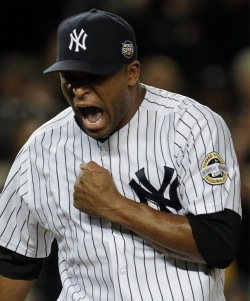
It came as no surprise last night when A.J. Burnett walked out of the dugout at end of the seventh. In the past, it might have been a bit more shocking. We’ve grown accustomed to seeing pitchers exit at around the 100-pitch mark, especially if he’s already completed seven innings. This year, however, it seems that Joe Girardi has become a bit more willing to let his pitchers cross that barrier. All of his starters, save for Vazquez, have started innings at or above 100 pitches.
When Burnett walked Nick Markakis with one out, though, it was clear he would leave the game. At 107 pitches and with his velocity fading — none of the seven fastballs he threw that inning broke 92 mph — the walk represented a logical end point for Burnett’s night. He had the game pretty well at hand, having dominated the Orioles for 7.1 innings, but there was a bit of trouble brewing. The walk brought Matt Wieters, the tying run, to the plate.
After Phil Hughes pitched seven innings on Sunday and CC Sabathia finished eight on Monday, the bullpen was well rested. Only Joba Chamberlain pitched on Tuesday, and only Mark Melancon, since optioned to Scranton, pitched on Sunday. Girardi had his pick of arms to face Wieters, who had homered off Sabathia on Monday. Normally this would have been Chamberlain for certain, but with Mariano resting a sore flank, Girardi wanted to use Joba in the ninth. His choice to face Wieters was lefty Damaso Marte.
When Girardi tapped his left arm on his way to the mound, I experienced a sinking feeling. Burnett had worked so hard, had pitched so well, and had out-dueled Orioles youngster Brian Matusz. If anyone could throw that all away with one pitch, I thought, it was Marte. There was nothing about the matchup with Wieters that made me comfortable. Even though he fares better against righties than lefties, I still would have preferred Al Aceves in that situation.
This runs counter to my initial feelings when the Yankees acquired Marte in 2008. After years of testing out lefty reliever after lefty reliever, it appeared that the Yanks had finally found their man. Though his numbers looked bad after joining the Yankees, much of that came in just one outing, a 40-pitch endeavor that never should have happened. I have no idea why Girardi left him in so long, but he had no business throwing anything past pitch 30. His poor start in 2009 left many Yankees fans sour on him, and even a dominant World Series run didn’t make many people more comfortable with him on the mound.
Marte has done little to quell the uneasy feeling this year. Though he didn’t allow a run of his own until Kendry Morales took him deep on April 25, he had a penchant for letting inherited runners score. In fact, he has allowed half the runners he has inherited to score — and that includes his strand of Markakis last night. In other words, while the Morales homer is the only blemish on his game log, he has still done plenty of damage. Those inherited runners hurt, mainly because Marte’s job usually comprises retiring just one batter.
Last night’s appearance, though, will perhaps make me less uneasy next time Girardi taps his left arm and calls for Marte. After missing with his first pitch he came back with a faster fastball, 92 mph, low in the zone. Count even, he then dropped a slider low and inside, a perfect spot to a righty who doesn’t hit lefties too well. Wieters took it for strike two. Marte came back with a similar pitch, this one a bit more under the hands, and all Wieters could do was foul it off. He didn’t bite on the next slider, which ended up in the dirt. On the last pitch, though, Marte shined. After the pitch in the dirt he elevated a fastball, this one 93 mph, and Wieters took the bait. He swung right under it for strike three.
That, of course, was only the second out of the inning, and with righty Miguel Tejada at the plate Girardi again went to the bullpen, this time to Aceves. And then, as if the baseball gods were telling me that my intuition sucks, Ace came within five or six feet of surrendering a game-tying homer.
I doubt I’ll actually feel less uneasy when Marte next enters a game. He has been shaky enough during his time in pinstripes that we don’t know what to expect. Last night’s batter faced, though, at least gives me a bit more hope. Not only did he do his job, but he did it well. I loved the pitch sequence, loved the location. A few more appearances like that and maybe I won’t curse Girardi for going back to Marte in big spots.
Bullpens prove the difference in weekend series
The Yankees executed the game plan well this weekend. They continued their penchant for taking pitches, which prevented each Angels’ starter from pitching the seventh inning. They knocked out Ervin Santana and Joel Pineiro after six, and tagged Scott Kazmir during that inning. The overall line for the Angels’ staters didn’t look too pretty:
17.1 IP, 22 H, 14 R, 14 ER, 6 BB, 8 K, 3 HR, 297 pitches (just over 17 per inning)

That left the Angels bullpen to cover 9.2 innings during those three days, which usually means success for the Yankees. They take pitches not only to work favorable counts, but also to tire out the starting pitcher. This means more innings for the bullpen, and since most bullpens feature pitchers weaker than the team’s starters the Yankees typically feast. At least, that’s the idea. Over the weekend the Angels’ bullpen pitched very well, allowing just one run in those 9.1 innings. Their final combined line:
9.2 IP, 3 H, 1 R, 1 ER, 5 BB, 7 K, 0 HR
Even with the five walks the Angels relievers allowed less than a base runner per inning, an excellent feat against a lineup like the Yankees. All three hits came during Saturday’s affair, a game which the Yankees had well at hand before Scot Shields relieved Joel Pineiro to start the seventh. In the two close games, Friday and Sunday, the Angels relievers held the Yankees to no hits and just three walks while striking out five in 6.2 IP.
This stands in contrast to what the Yankees bullpen accomplished over the weekend. While the Angels relievers were busy keeping the Yankees off the base paths, the Yankees relievers proceeded to blow two close games. That’s not an indictment of the entire staff, of course. David Robertson pitched very well in his two-out stint on Friday, retiring both batters he faced. Instead, it was just two relievers who performed poorly for the Yankees, Joba Chamberlain and Damaso Marte.
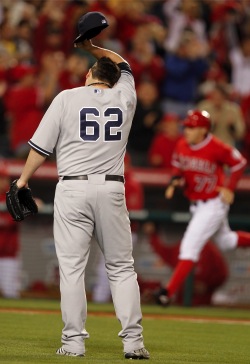
On Friday night Joba opened the inning by allowing a single and a homer. He continued his shakiness, allowing a single and a deep fly ball to the next two batters before settling down a bit and retiring the side on two easy fly balls. On Sunday Marte clearly didn’t have it, as he walked a guy and hit a guy before falling behind on Kendry Morales 3-0. There were plenty of questions to ask afterwards, including why Girardi let Marte throw that pitch to Morales. It was also questionable to remove Aceves after his 1.2 perfect innings. No matter the management, though, those two losses are on the relievers who allowed the runs (though Sunday’s loss is much easier to pin on Vazquez).
Other than those two performances, the Yankees’ bullpen did just as well as its Angels counterpart. Boone Logan, Sergio Mitre, Al Aceves, David Robertson, and Saturday’s Damaso Marte combined for the following line:
5.1 IP, 2 H, 0 R, 0 ER, 2 BB, 3 K
The Angels just happen to run into a couple of bad performances. On another weekend perhaps the Yanks take better advantage of Fernando Rodney’s wildness, maybe they mount a rally against Brian Fuentes, maybe they can hit Jason Bulger and Scot Shields like the rest of the league has to this point. This weekend, though, the Angels bullpen won. The Yanks bullpen made a valiant effort, but two poor performances from otherwise good relievers were the differences in two games. That will happen.
- « Previous Page
- 1
- 2
- 3
- 4
- 5
- …
- 9
- Next Page »